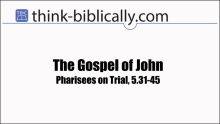
Jesus continues to teach the crowds, and the Jewish leaders have still not moved to arrest him. In his usual fashion, Jesus makes some statements to teach and others to confuse his adversaries. Still testifying about himself and his Father, Jesus speaks in such a way that some will understand and others will not. This is evidence by the various reactions the people have to his teaching as recorded by John. Verse 21 is a typical example of such language, "I am going away… Where I am going you cannot come," he said. The religious leaders immediately tried to discern his meaning.

The story is referred to by early church fathers as the Pericope Adulterae, but to modern readers it is know as the Adulterous Woman, or A Woman Caught in Adultery. You know the one, where a woman caught in adultery is brought before Jesus to be stoned? Jesus challenges the crowd with the words, "he who is without sin cast the first stone." It is one of the most well-known stories in the New Testament and, surprisingly, not original to the New Testament at all. All the earliest manuscripts omit the story, and among the later it shifts location.

Our text today takes place during the Feast of Tabernacles. Jesus was teaching around Galilee when the feast came to pass. He knew the religious leaders in Jerusalem were plotting to kille him, so he avoided them in the hillside. Jesus told his half-brothers his time had not yet come, but it would within a single year of this event. Not wanting to miss out on an opportunity, however, and snuck into the city. Halfway through the feast, Jesus decided to break cover and begin teaching in the temple. Verses 14-24 are a very compressed dialogue between Jesus and all present.

Last week we spent some time examining Jesus' second greatest miracle, the feeding of the 5,000. In doing so, we covered John chapter six verses one through 15, and 22-65, but left out the very important passage of Jesus walking on the water. After the miracle which multiplied the fish and the loaves to feed thousands of people, Jesus told the disciples to take a boat to Capernaum. While they rowed, Jesus decided to walk it, just not in the usual manner. John leaves an awful lot of this story on the cutting room floor, but adds a fascinating aspect to the miracle.

If we remove the first 11 verses of chapter eight we have a continuity problem with today's passage, 8.12-20. Chapter seven ends with the religious leaders planning Jesus' fateful end, and in chapter 8 verse twelve Jesus is again teaching in the temple. The story of the Adulterous Woman provides us with the reason Jesus is back in the temple teaching, which is another reason I think it is a mistake to simply eliminate the pericope from the Bible. In today's passage, Jesus is at the temple, standing near the offering box, to teach the gospel using a metaphor.

The Feast of Tabernacles is still underway, in fact John identifies it as the both the last day, and the greatest day which presents a problem for modern readers. According to Deuteronomy 16 the feast was 7 days, with a ceremony of water and lights on the seventh day (Mishna, Sukkah 4). This is likely the day that John means, though Leviticus 23.36 mentions an eighth day which was intended as a day of holy assembly. Due to the seventh day having a celebration, and the eighth being described as a solemn assembly, the seventh is more likely to be the "greatest day".

Today we begin exploring John's fourth movement in the book, The Conflict of Men Against the Messiah, starting with chapter seven through chapter 12. John begins this section by explaining the climate toward the Messiah. One could compare Jesus' popularity with that of America's current president, Donald Trump. Jesus was very popular among the common people across the land, but reviled by religious and political powers especially those found in the larger cities of Israel. Some scholars note that John is anti-Jewish, but his explanation of events here and elsewhere show a balanced telling of true history.

While I would never desire to alienate our readers around the globe, today is a distinctly American holiday. July 4th is the day we celebrate our independence. Independence from oppressive taxes, from unjust political rulers, from being a vasal of the British Empire. I thought a lot about writing of the spirituality and miracles surrounding General George Washington, one of the men responsible for our independence and America's first President, but I think I'll save that for Laobr day. Today is a holiday in my homeland, and as such a time to be spent with friends and family.

While we may not be able to state this story is true, one thing we can be sure of and that is that it doesn't contradict anything revealed in Scripture about Jesus, Biblical theology or any other truth. We also know that it is an ancient story, one that began in the early church and whose roots may go back to the time of Christ. It may be a true story, even though it was likely not written by one of the Bible's authors. We'll leave the debate as to its canonical status to the scholars; today we'll examine the story itself.

Today we are picking up right where we left off yesterday. Knowing that the Pharisees in Jerusalem wanted to kill him, Jesus went into town anyway to celebrate the Feast of Tabernacles. It should be noted the while the feast looked back to the time before Israel was a nation and the people wandered the desert living in tents (or tabernacles) in the presence of God, it also looked forward to the day when God would once more dwell with man. There is no little irony then, that Jesus — God in the flesh — was walking among them during this feast period.

At the beginning of chapter six we are on a figurative mountain peak. The people are on a spiritual high. Jesus was in rare form while preaching throughout the day, then had fun with them and the disciples by multiplying three loaves and fish to feed thousands. The people ate until they were full, a rare occasion indeed, and everyone felt closer to the Messiah. Little did they know that their next few steps with Jesus would take them into the valley. The trip was so quick no one saw the darkness closing in, the space between them shrinking and tempers shortening.

After giving the Pharisees a theology lesson, he takes them to court. Not literally, of course, but he uses the language of a trial — "testimony" and "deeds" and "accuse" — to make the case that he is indeed the Messiah. The first line of today's passage, however, is both surprising and confusing. Jesus states, "If I testify about myself, my testimony is not true." What did Jesus mean and why is his word not enough? I think the answer is in the law, and the two courts in which a person can be judged.

